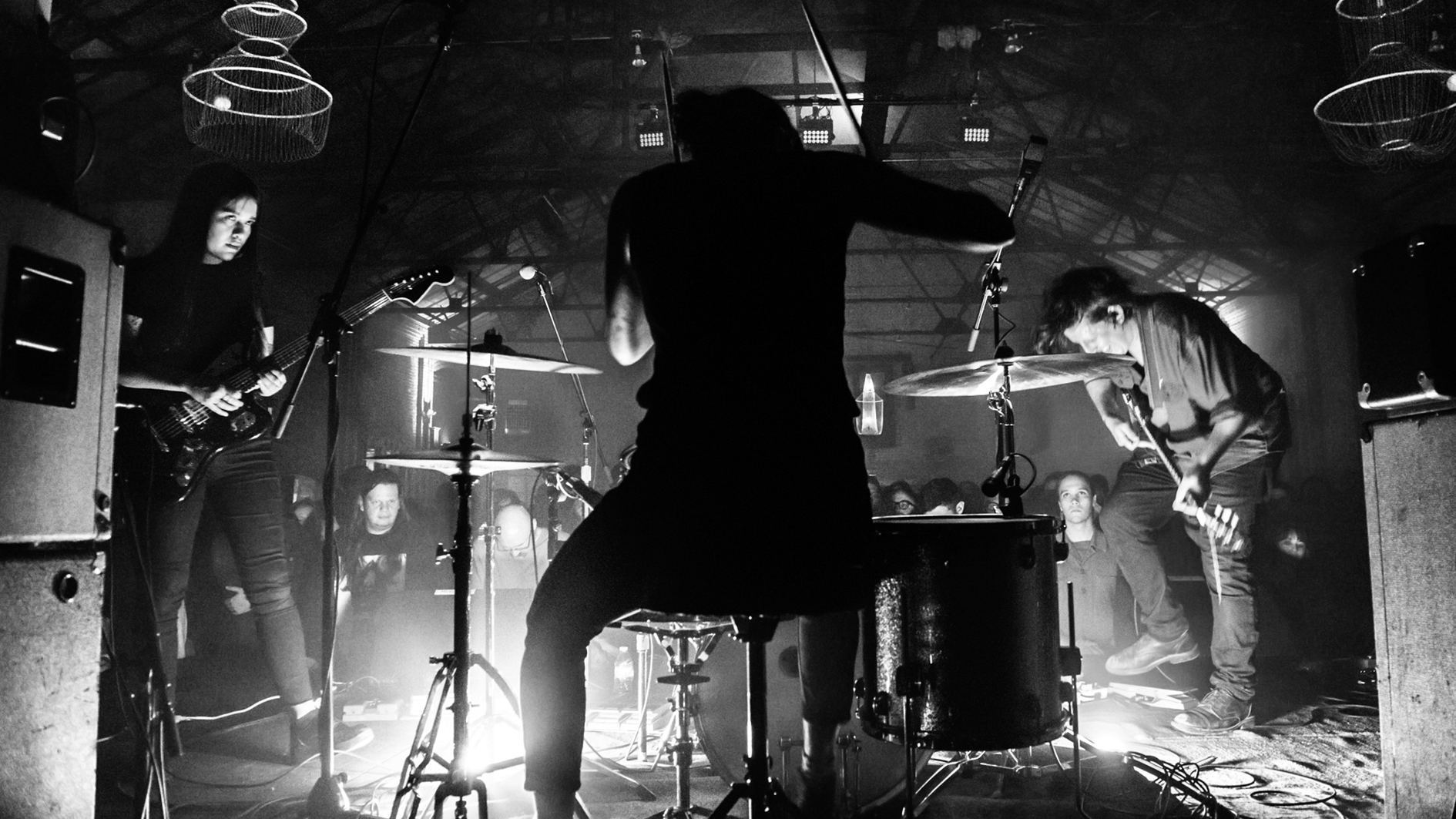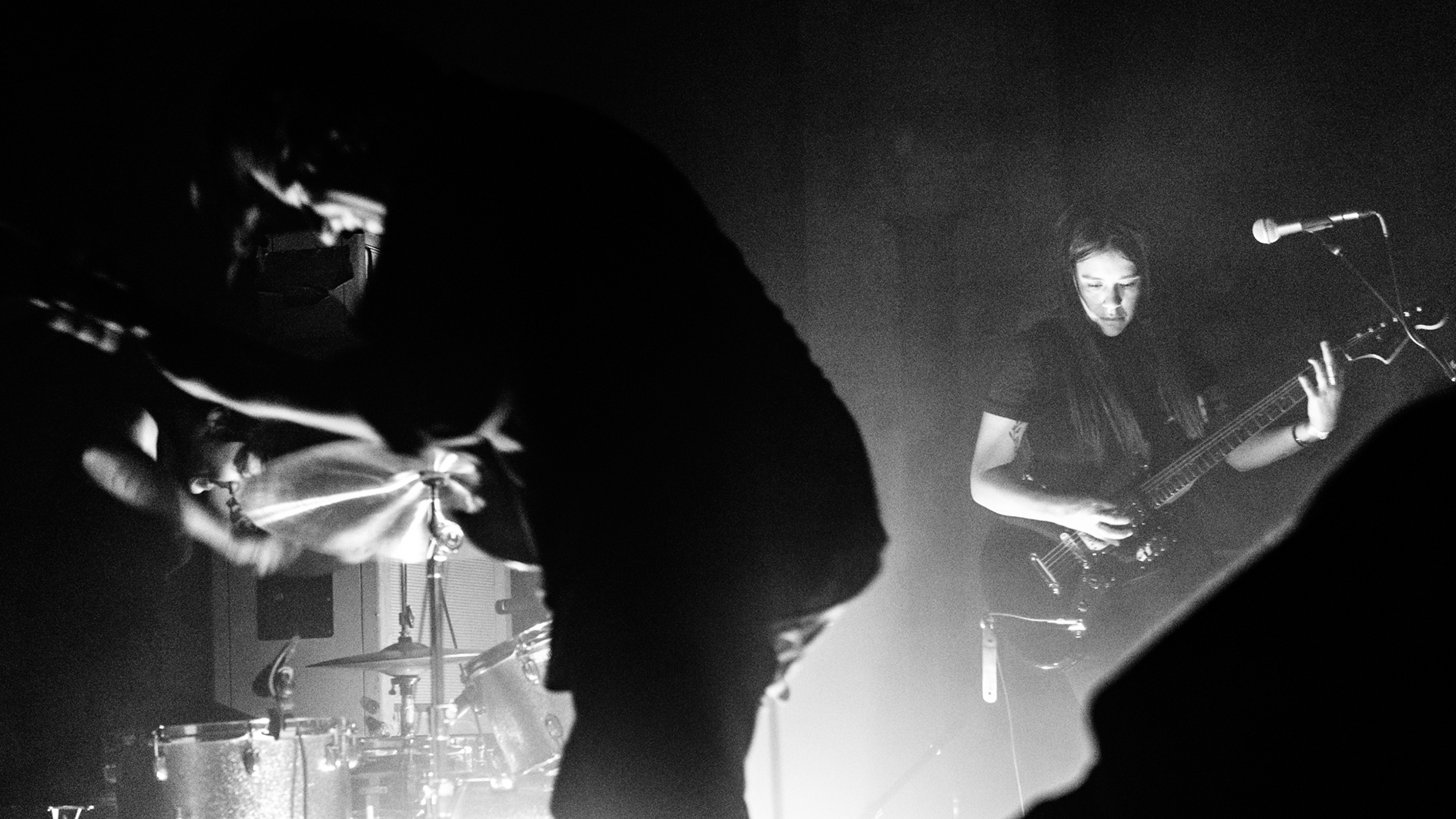BIG|BRAVE's Mathieu Ball: “Whenever we play something too musical, I feel it’s almost a cop out. We have to get rid of any traditional guitar playing!”
Ball talks open tunings, eschewing leads and using a hand-built guitar on Vital, the Montreal trio's biggest and bravest drone-metal offering yet

BIG|BRAVE co-founder Mathieu Ball suggests that the long-running Montreal metal trio aims to keep their music “as bleak as possible”. Fittingly, Vital, the band's newest, Polaris Music Prize-nominated album, delivers stark, long-form crushes – subsonic fields of low-tuned, slow-rolling chord work arguably paying homage to both the symphonic Montreal post-rock scene of the past 20 years, and the minimalist, yet towering dirges of Sunn O))).
On Vital, Ball, guitarist/vocalist Robin Wattie and drummer Tasy Hudson further refine that blunt drone-metal aesthetic. Half-Breed, for instance, spends its first few minutes contrasting Wattie’s raw, octave-hopping howl against the resolute, cone-tearing push of a single chord – at least before snaking into its mid-section’s sinister groove.
A woodworker by day, Ball tested the mettle of these steely-eyed surges with a self-carved SG-style guitar and an array of boosts cramming through both his Hiwatt Custom 50 and a Music Man RD100.
“I try to stay away from distortion, especially with this guitar I built. I love the sound so much. I felt that adding distortion would suck the tone out. I’ve really tried to stay away from that to get the sound of the pickups with the amp, pushing it without modifying it too much,” he says, before adding, “but there is a Big Muff that I’ll use for when things get absolutely crazy.”
While BIG|BRAVE recently announced a collaborative album with The Body due in the fall, Ball spoke with Guitar World on how, with Vital, the trio just may have delivered their biggest, bravest, and – yes – most vital drone-metal masterstroke yet.
BIG|BRAVE have called Vital “the most collaborative record” you’ve made so far. Since the band has existed for a dozen or so years, how much of a breakthrough was it to arrive to this point?
“Well, we’ve been through a few drummers at this point. Tasy is our third. In the past, Robin and I would write a lot of the music, and drums would come in at the very end. But with Tasy, we really put these songs together, the three of us. The outcome is not that different, but everything’s a little more intertwined.”
Get The Pick Newsletter
All the latest guitar news, interviews, lessons, reviews, deals and more, direct to your inbox!
Has that collaboration led you towards harnessing the sound of the band any differently – the treatment of feedback, the spatial awareness. There are naturally some big, humming parts to Vital, but there are some absolutely silent moments to the LP as well.
“That’s something we’ve been playing with since the 2015 record [Au De La], and I think it’s something we always want to go back to. We play with silence as much as we can, but then again, my instinct is always to do more.
“It’s kind of uncomfortable to not play, especially live. You have to make an effort. It’s harder than actually doing something on your instrument. It’s a good exercise, that restraint.”
You’re a band that has consciously avoided using bass on your recordings, but on the big mid-section explosion in Half Breed it sounds like there’s this bassline snaking around beneath the two more sustained, distorted guitar tracks.
“That’s Robin. Robin plays through an SVT and an 8x10, as well as through her Orange amp. On the bass amp, the bass is [dialed in] at 10, and the treble is at 0 – all that comes through is the low-end.
It’s kind of uncomfortable to not play, especially live. You have to make an effort. It’s harder than actually doing something on your instrument. It’s a good exercise, that restraint
“For that part, she’s playing with the headstock of the guitar pressed against the cabinet, just doing this physical feedback loop where the cabinet rumbles the strings. It’s one of my favorite parts. It sounds like this mystical beast.”
On the next song, Wited. Still and All..., you’re playing with more ambience and stillness than some of those heavier, distorted moments. Was that scripted, or improvised?
“That piece was improvised. We had a rough chord progression that we knew we wanted to use, but we also knew that we were going to put that song together in the studio.
“Since there’s such an emphasis on rhythm and drum patterns [throughout the rest of the record], we knew we’d want a break in there – a dronier, more abstract piece.
“I think we might’ve done that one last, when we took the amps out of our individual booths, put them in the main room, and built an amp wall. Robin and I just jammed around, and Tasy added some percussion near the end.”
In terms of that amp wall, what were you going through for your own rig?
“I’ve been using a Hiwatt Custom 50 and a Music Man RD100; I’m not picky with the cabinets. I have Orange cabs here at home, but I used whatever Seth [Manchester], the engineer, had at the studio [Pawtucket, Rhode Island’s Machines with Magnets].
“Robin had been using an Orange Rocker 30 live, but for the sessions we had time to play around with all the amps, and she ended up using the Traynor YBA-4.
“It just sounded better, so that’s something we’re going to have to find when we get to playing shows again. There’s more clarity than the crunch of the Orange, while still sounding quite mean.”
Were you rotating guitars at all? I know at one point Robin was using a Jaguar. When you had the Zoom video on earlier, I noticed you had an SG on your wall...
“That’s the guitar I used to use, but I have since built a guitar. That’s what’s on these recordings. I got an aluminum neck from Scott Hughes – the company is called Obscura.
“I’d always wanted to build a guitar – I’m also a woodworker, so I thought this was something I could do [and] I had time during the pandemic to build it.
Since we don’t play riffs, the tuning doesn’t really matter
“It’s kind of an SG-style, because I wanted it to fit in all my road cases – I didn’t want to have to buy all-new flight cases, you know? I put in some P-90s from Electrical Guitar Company, and the guitar sounds amazing. I have not gone back to the SG since.
“Robin is still using the Jaguar. She has a thick gauge of string on there, I think .58s?”
In terms of tuning, I might’ve picked out an open C?
“It’s kind of a weird open B tuning that we developed for this set of songs. It’s in B, but I think there’s a capo on one song. There are some weird things happening in there.
“I think Robin is tuned to B and F# all the way through, though I couldn’t tell you which string is which. Just the two notes, though. I’m in a similar thing, B and F#, but there’s an open 7th in there.”
Have you reverse-engineered any older songs with that tuning?
“We rarely go back to the older stuff. We’re constantly moving forward, [but] I think we’ll revisit some songs from [2019’s] A Gaze Among Them.
“Since we don’t play riffs, [the tuning] doesn’t really matter. There’s an absolute lack of riffs in our songs – most of what we do is open strumming; I’m playing with feedback a lot. It’d change the key of the songs, but we wouldn’t have to relearn anything.”

With that in mind, can we talk about Vital, the title track? In the closing moments, there’s arguably the closest thing to a lead, this sparkling high lick drenched in reverbs and delays. I’m wondering if you can get into that busier moment, and how leads even relate to a band that’s purposefully this minimal and visceral.
“We like doing that kind of stuff, but we try not to do it too often. It sounds too much like a rock band, so we’ll ditch it, but every once in a while we’ll keep a part like that. With that last part [in Vital], it’s probably the heaviest part on the record, so I guess I just allowed myself to play a small lead there.
“I wouldn’t want to do that all over the record, but these things – these standard rock elements – it’s like, ‘Are we allowed to do this?’”
Have you ever been tempted to just rip out some raging shred solo?
“Umm... no [laughs]. Our approach to band music and guitar... it’s a rock band, but it really leans on the experimental side. Whenever we play something that’s too musical, I feel like it’s almost a cop out. [Anything] that’s based in traditional guitar playing... we have to get rid of that. That’s been the main focus of this band.”
Gregory Adams is a Vancouver-based arts reporter. From metal legends to emerging pop icons to the best of the basement circuit, he’s interviewed musicians across countless genres for nearly two decades, most recently with Guitar World, Bass Player, Revolver, and more – as well as through his independent newsletter, Gut Feeling. This all still blows his mind. He’s a guitar player, generally bouncing hardcore riffs off his ’52 Tele reissue and a dinged-up SG.
“Every tour was the best I could have done. It was only after that I would listen to more Grateful Dead and realize I hadn’t come close”: John Mayer and Bob Weir reflect on 10 years of Dead & Company – and why the Sphere forced them to reassess everything
“Last time we were here, in ’89, we played with Slash on this stage. I don't remember what we did...” Slash makes surprise appearance at former Hanoi Rocks singer Michael Monroe's show at the Whisky a Go Go




![John Mayer and Bob Weir [left] of Dead & Company photographed against a grey background. Mayer wears a blue overshirt and has his signature Silver Sky on his shoulder. Weir wears grey and a bolo tie.](https://cdn.mos.cms.futurecdn.net/C6niSAybzVCHoYcpJ8ZZgE.jpg)

![A black-and-white action shot of Sergeant Thunderhoof perform live: [from left] Mark Sayer, Dan Flitcroft, Jim Camp and Josh Gallop](https://cdn.mos.cms.futurecdn.net/am3UhJbsxAE239XRRZ8zC8.jpg)





